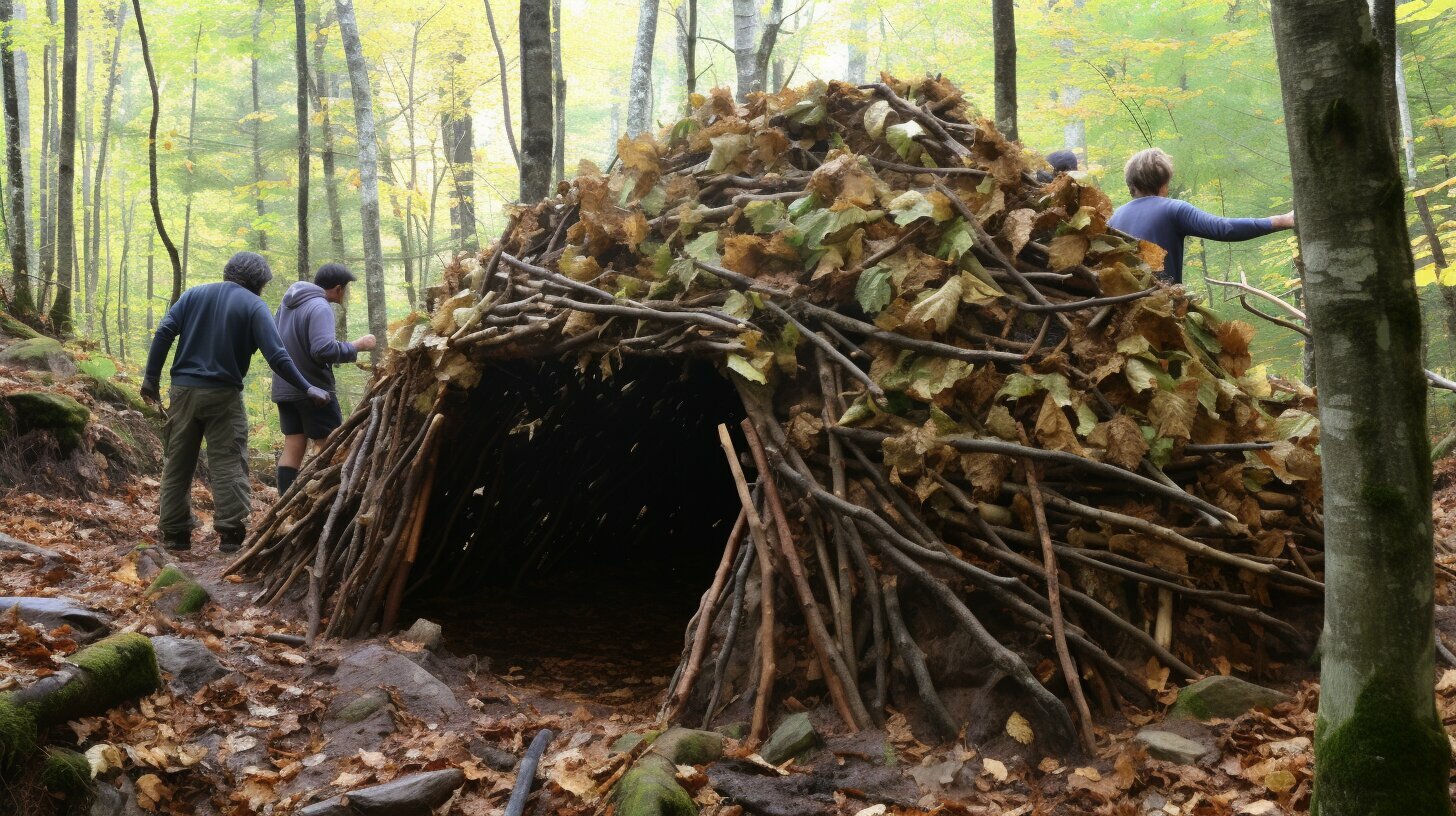When venturing into the great outdoors, constructing a shelter is an essential skill to have. Whether you’re planning a camping trip or exploring the wilderness, knowing how to build a natural shelter can be a lifesaver.
It’s important to learn the necessary techniques and skills for constructing shelters in outdoor environments. This guide will provide you with all the essential information to become proficient in natural shelter construction.
Key Takeaways
- Constructing a natural shelter can be a lifesaving skill in outdoor environments.
- The fundamental concepts of shelter building include selecting a suitable location, choosing appropriate materials, and understanding different construction methods.
- Essential tools and materials for shelter construction include natural resources like branches, leaves, and rocks, as well as additional tools that may be useful.
- Choosing the right location is crucial for shelter construction, considering factors such as terrain, proximity to water sources, wind direction, and safety from wildlife.
- Building a basic, primitive shelter using natural materials and techniques is a simple and functional way to construct a shelter.
- Sustainable and eco-friendly shelter construction methods can minimize environmental impact, utilizing renewable materials and reducing waste.
- Advanced wilderness shelter construction techniques include multi-room shelters, raised platforms, and incorporating natural insulation.
- Effectively utilizing available resources and overcoming challenges in shelter construction are important skills to develop.
- Safety considerations, including fire safety, stability, and ongoing maintenance, are crucial for a functional and safe shelter.
Understanding Shelter Building Basics
Building a shelter in the great outdoors can be an essential skill for any adventurer or survivalist. To construct a suitable shelter for your needs, you must first understand the basics of shelter building and the techniques required.
The first step in building a shelter is to determine the type and size of the shelter you need. Consider the number of people who will be occupying the shelter, the weather conditions, and the length of time you will be staying. Once you have determined these factors, you can move on to selecting a location.
Disclosure: When you buy through links on our site, we may earn an affiliate commission.
The location of your shelter is crucial for shelter building, and there are several factors to consider when selecting a location. Look for an area that is dry, flat, and has good drainage. Avoid areas that are prone to flooding and are exposed to strong winds. Additionally, be mindful of any potential hazards, such as falling rocks or dead trees.
Next, you need to select appropriate materials for your shelter. Depending on the environment, materials can vary from branches, leaves, and grasses, to snow, ice, and rocks. You will also need tools for shelter construction, such as a survival knife, saw, and axe.
Once you have gathered your materials and tools, you can begin the construction process. There are various shelter construction techniques, including lean-to, A-frame, and debris hut. The lean-to is a simple shelter that relies on a slanted roof against a support, while the A-frame shelter is more complex and requires a frame on which to attach your roofing materials. The debris hut is a shelter that utilizes natural materials, such as branches and leaves, to create a weatherproof shelter.
When building your shelter, always keep in mind the importance of staying dry and shielding yourself from the elements. Building a shelter can be challenging, but with the right techniques and skills, you can construct a shelter that will keep you safe and comfortable.
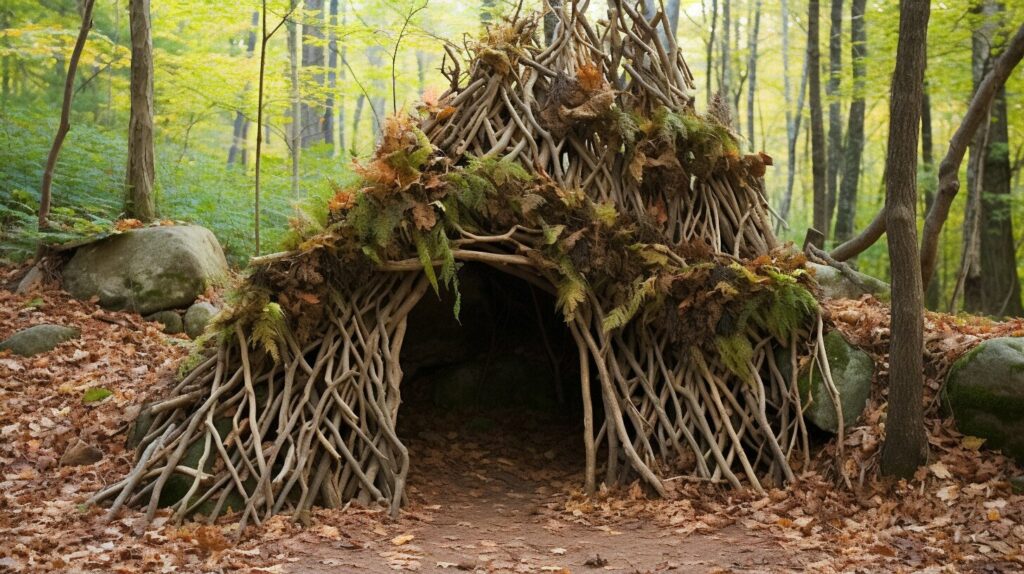
Essential Tools and Materials for Shelter Construction
Building a natural shelter requires using materials found in the surrounding environment. The right combination of materials can make a difference between a sturdy and secure shelter and one that fails in the middle of a storm. Therefore, it’s essential to have a good understanding of the materials required for constructing a shelter in the wild.
Some of the most commonly used materials for shelter construction include branches, leaves, vines, and grass. You should select strong and sturdy branches that are not dead or brittle, as these are more likely to break or snap under pressure. Choose leaves that are large and wide, and not too dry or fragile. Make use of vines and grass to weave together to create a tight and secure shelter.
One of the most crucial pieces of equipment when constructing a natural shelter is a good quality knife. A knife can be used to cut branches, trim leaves and vines, and prepare other materials for your shelter. Other vital tools include a saw, hatchet, hand drill, and cordage.
Having the right tools and materials is necessary, but it’s equally important to know how to use them. Carrying a book on shelter construction or watching online tutorials can help you understand the appropriate ways to use these tools correctly.

It’s also essential to keep the environment in mind while constructing your shelter. Always aim for sustainable and eco-friendly methods. Be sure to use materials appropriately and avoid over-harvesting one area. This way, you can make use of the resources available in the area while also preserving it for future generations.
Choosing the Right Location for Your Shelter
To construct an effective natural shelter, selecting the right location is crucial for your survival. When scouting for a location, consider the type of environment you are currently in. Look for a spot that provides natural protection from the elements and is not prone to flooding. Build your shelter on high ground, and not in a dry river bed or areas susceptible to flash floods.
Be aware of the movement of the sun – this will help you to avoid building your shelter in direct sunlight, especially during the hotter parts of the day. Also, take note of the prevailing winds in the area. Construct your shelter so that the opening faces away from the wind to minimize exposure to it.
| Top Tips: |
|---|
| #1: If possible, choose a location near a water source to ensure access to clean drinking water. |
| #2: Look for natural features that can help you build your shelter – like a rocky overhang or a well-located tree that can act as a support structure. |
Remember also to consider the availability of resources around your chosen location. Make sure you have access to materials for building your shelter, such as branches, leaves, and rocks. Lastly, assess the safety of your location. Avoid areas with potentially dangerous predators, such as bears or cougars.
Remember that shelter building isn’t a one-time endeavor. You may need to relocate your shelter if the weather changes or if you find a better location. Be adaptable and flexible.
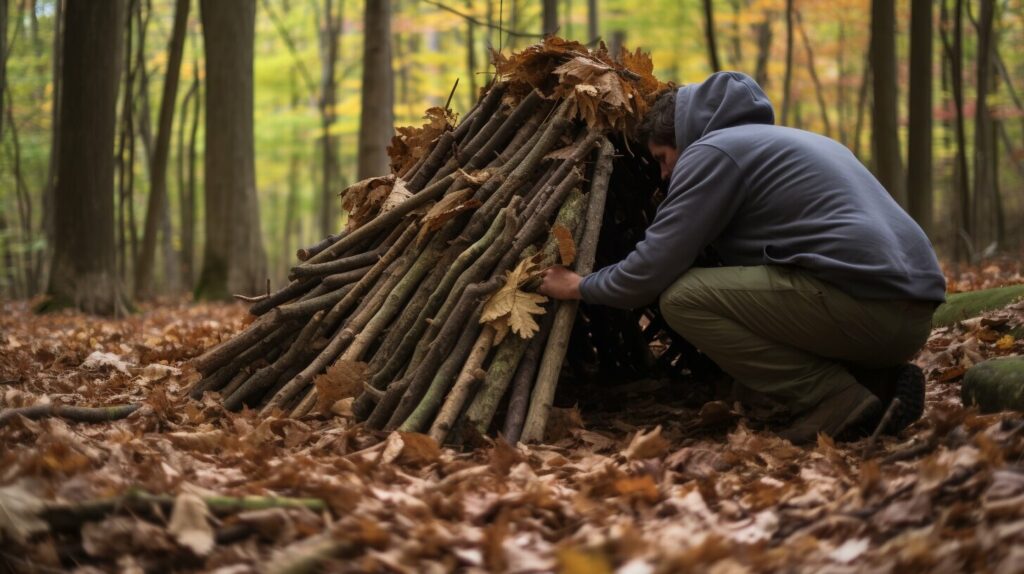
Building a Primitive Shelter
When it comes to constructing a primitive shelter, simplicity and functionality are key. The following step-by-step guide will help you build a basic shelter using natural materials and techniques.
- Identify a location that provides adequate shelter from the wind, rain, and sun. Look for a spot with plenty of natural materials like branches, leaves, and bark.
- Construct a frame for your shelter using sturdy branches. Lean them against a tree or against each other in the shape of an A-frame. Secure the branches in place by driving sticks into the ground to create a stable foundation.
- Layer smaller branches, leaves, and grass on top of the frame to create a thatched roof. Cover the entire structure with a waterproof material like bark or woven grass and secure it in place with vines or cordage.
- Build up the walls of your shelter using natural materials like mud, clay, or stacked rocks. This will provide insulation and protection from the elements.
- Finally, create a comfortable interior by using soft natural materials like grass, leaves, and pine needles to cushion the ground. You can also use pine boughs to create a bed or sleeping area.
Remember that a primitive shelter is meant to provide basic protection from the elements, not all the comforts of home. With a little practice and ingenuity, however, you can master the art of primitive shelter construction and stay safe and comfortable in any outdoor environment.
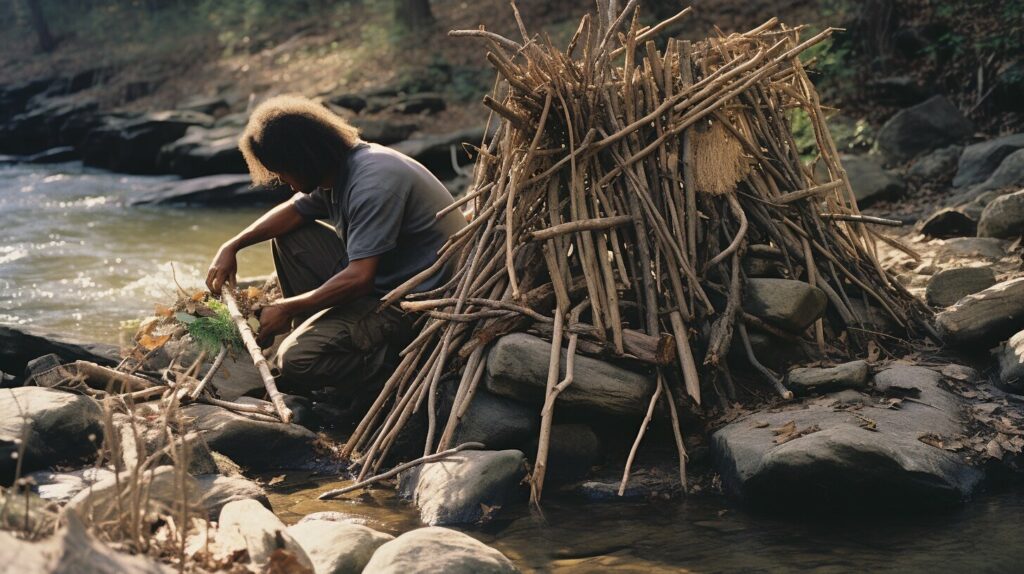
Sustainable and Eco-Friendly Shelter Construction
When constructing natural shelters, it’s important to consider the impact on the environment and aim for sustainable and eco-friendly methods. By using renewable materials and minimizing waste, you can reduce your ecological footprint and ensure a more harmonious relationship with nature.
One technique for sustainable shelter building is to use natural materials that are readily available in the surrounding environment. This includes using branches, leaves, and rocks, as well as other resources that can be sourced sustainably, such as fallen trees.
In addition to using renewable resources, it’s important to minimize any negative impact on the environment. This means avoiding damaging or removing live trees or vegetation, as well as properly disposing of any waste materials. You can also consider using biodegradable materials or repurposing materials that would otherwise go to waste.
Another way to promote sustainable and eco-friendly shelter construction is to incorporate green technologies, such as solar panels or rainwater collection systems. These methods can help reduce reliance on non-renewable resources and minimize the impact of building your shelter on the natural environment.
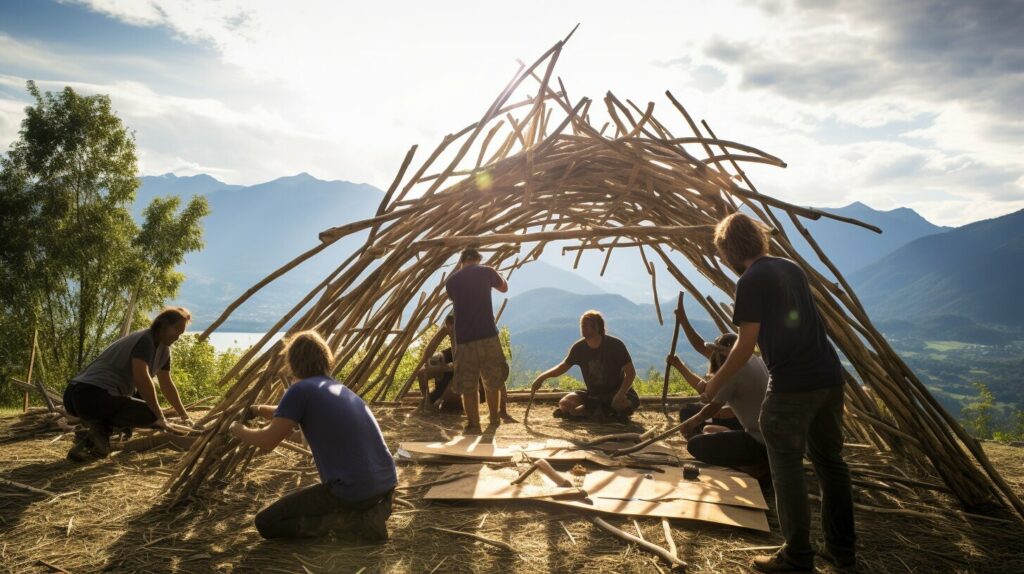
By considering these eco-friendly techniques and strategies, you can build natural shelters that not only provide reliable protection in outdoor environments but also help sustain the natural environment for future generations.
Advanced Wilderness Shelter Construction Techniques
When it comes to building shelters in the wild, sometimes basic structures just won’t cut it. If you’re facing harsh weather or extended stays in the wilderness, you’ll need to know some advanced techniques for natural shelter construction.
One option is to build a multi-room shelter, which can provide separate spaces for sleeping, cooking, and storage. To do this, you’ll need to construct multiple frames and connect them securely with sturdy branches or vines.
Another advanced technique is to build a raised platform shelter. This can help keep you off the ground in wet or cold conditions, and can also provide added protection from wildlife. To build a raised platform, you’ll need to construct a sturdy frame and then add layers of branches and leaves for insulation and comfort.
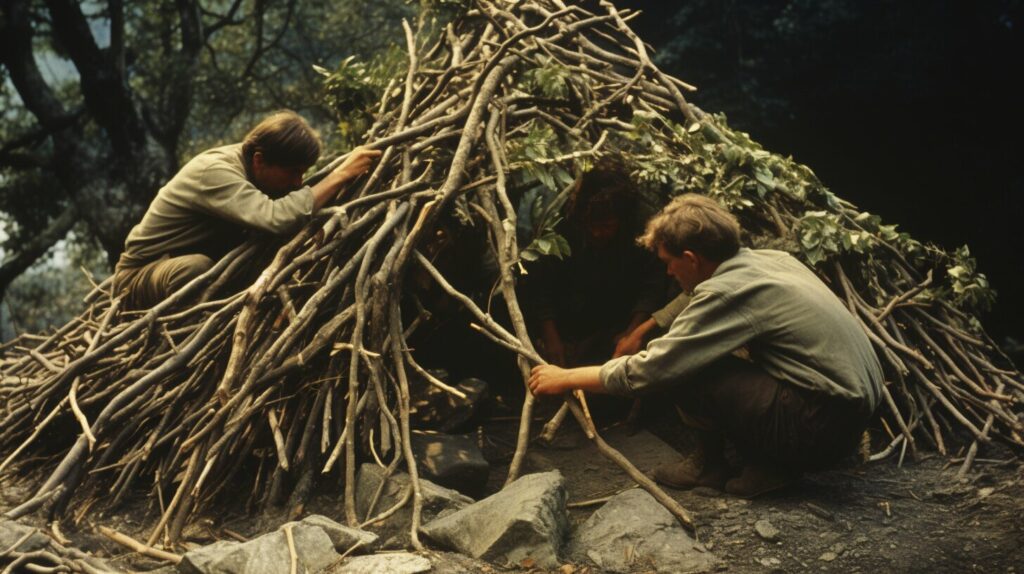
If you’re facing extreme cold, you may want to incorporate natural insulation into your shelter design. This can include materials such as pine needles, grass, or even animal fur to help trap warmth and keep you comfortable.
Incorporating these advanced techniques into your natural shelter construction arsenal will help you be better prepared for any wilderness survival situation.
Tips for Effective Resource Utilization
Building a natural shelter requires utilizing the resources available to you in the surrounding environment. With the right techniques and knowledge, you can effectively identify, harvest, and utilize these resources to construct a functional and sturdy shelter. Here are some tips for effective resource utilization in natural shelter construction:
- Scout your area: Take a walk around the area and identify resources that can be used for shelter construction. Look for sturdy trees, branches, leaves, and rocks that can be used as building materials.
- Be selective: Not all resources are created equal. Choose sturdy and dry materials that are suitable for your shelter’s location, weather conditions, and required functionality.
- Take only what you need: Be mindful of the environment and only take what you need for your shelter construction. Remember that other wildlife and outdoor enthusiasts rely on these resources as well.
- Use renewable resources: Whenever possible, use renewable resources such as fallen branches and leaves that are naturally available in the environment. This helps to minimize your impact on the environment.
- Learn to improvise: Being resourceful is key in natural shelter construction. If you don’t have access to certain materials, be creative and think of alternative solutions.
- Get creative with knots: Mastering different knots and lashings can help you securely fasten branches together to form your shelter’s frame.
With these tips, you can construct a natural shelter that provides protection from the elements and the wildlife, while minimizing your impact on the environment. Happy building!

Overcoming Challenges in Shelter Construction
Building a natural shelter can be a challenging task, but with the right techniques and mindset, you can overcome obstacles and create a safe and comfortable place to rest. Here are some common challenges you may encounter while building a natural shelter and how to address them:
Limited Resources
When building a natural shelter, you must rely on the resources available in your environment. If you’re in an area with limited resources, you may need to be creative and resourceful in finding materials for your shelter. Look for fallen branches, leaves, and other natural debris that can be repurposed as building materials. Consider alternative materials, such as pine needles, moss, or animal hides, if available.
Inclement Weather
Building a shelter in inclement weather can be challenging, especially if you’re dealing with rain, snow, or high winds. To address this challenge, try to work quickly and efficiently, using available resources to create a sturdy and weather-resistant shelter. Choose a location that provides some natural shelter from the elements, such as under a large tree or against a rock formation.
Time Constraints
If you’re building a shelter in a survival situation, time may be of the essence. To optimize your time, focus on building a simple and functional shelter that provides adequate protection and comfort. Prioritize essential tasks, such as building a fire and collecting water, to ensure your basic needs are met.
Safety Concerns
Building a shelter in a wilderness environment requires attention to safety concerns, such as avoiding dangerous wildlife, building a stable and secure structure, and ensuring fire safety. Be aware of any potential hazards in your location and take steps to mitigate risks, such as building a fire pit away from the shelter and securing your shelter against strong winds.
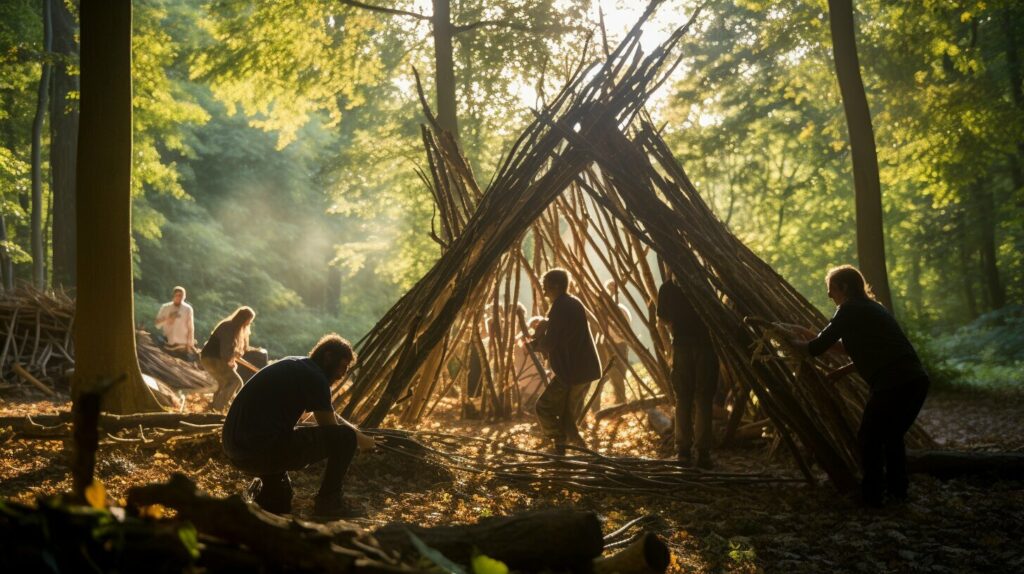
Safety Considerations and Shelter Maintenance
When constructing natural shelters for outdoor environments, safety should always be a top priority. One of the most important things to consider is fire safety. Make sure to clear the area around your shelter of any flammable materials and always have a means of extinguishing a fire nearby.
Additionally, the stability of your shelter is crucial to preventing collapse and injury. Double-check that all supports are securely in place and that the shelter is well-balanced.
Ongoing maintenance is also essential for ensuring longevity and functionality of your shelter. Regularly check for any damage or wear and tear, and make any necessary repairs.
Keep in mind that outdoor shelters are subject to the elements and natural wear and tear. While you may need to rebuild or repair your shelter over time, with the right techniques and materials, it can last for years to come.
Remember, when it comes to natural shelter construction and outdoor shelter construction, safety and maintenance are key. By prioritizing both, you can enjoy your shelter for years to come.
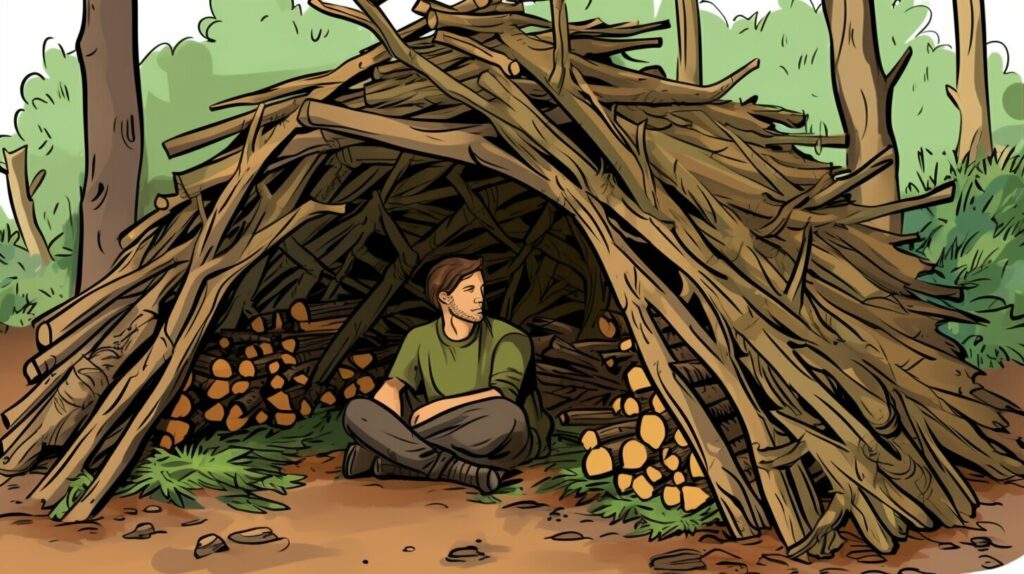
Conclusion
You have now mastered the art of natural shelter construction and are equipped with the knowledge and skills to build a shelter in any outdoor environment.
Remember, shelter building is an essential survival skill that could potentially save your life in emergency situations. By understanding the basics of shelter construction, choosing the right location, utilizing available resources, and maintaining safety, you can build a functional and sustainable natural shelter.
Don’t forget to continue honing your skills and exploring more advanced techniques for wilderness shelter construction. Remember to always prioritize eco-friendly and sustainable methods to minimize your impact on the environment.
Overall, the key to successful natural shelter construction is patience, persistence, and practice. Now, get out there and put your skills to the test!
FAQ
Q: What is natural shelter construction?
A: Natural shelter construction refers to the process of building shelters using materials found in the surrounding environment, such as branches, leaves, and rocks.
Q: Why should I learn natural shelter construction?
A: Learning natural shelter construction techniques is important for outdoor enthusiasts and survivalists as it allows you to create shelter in emergency situations or when camping in remote areas where traditional shelter may not be available.
Q: What are some basic shelter building techniques?
A: Basic shelter building techniques include selecting a suitable location, choosing appropriate materials, understanding different construction methods, and ensuring stability and functionality.
Q: What tools and materials do I need for shelter construction?
A: Essential tools and materials for shelter construction include natural resources like branches, leaves, and rocks. Additional tools such as a knife, saw, and cordage may also be useful.
Q: How do I choose the right location for my shelter?
A: When choosing a location for your shelter, consider factors such as terrain, proximity to water sources, wind direction, and safety from wildlife.
Q: What is a primitive shelter?
A: A primitive shelter is a basic shelter constructed using natural materials and techniques, focusing on simplicity and functionality.
Q: How can I build a sustainable and eco-friendly shelter?
A: To build a sustainable and eco-friendly shelter, use renewable materials, reduce waste, and minimize environmental impact.
Q: Are there more advanced shelter construction techniques?
A: Yes, advanced shelter construction techniques include building multi-room shelters, raised platforms, and incorporating natural insulation.
Q: How can I effectively utilize available resources in shelter construction?
A: To effectively utilize available resources, learn how to identify and harvest suitable materials from the surrounding environment and make the most of what you have.
Q: What challenges may arise during shelter construction?
A: Common challenges during shelter construction include inclement weather, limited resources, and time constraints. Practical solutions and workarounds can help overcome these challenges.
Q: What safety considerations should I keep in mind?
A: When building and using natural shelters, prioritize fire safety, stability, and ongoing maintenance to ensure longevity and functionality of the shelter.

